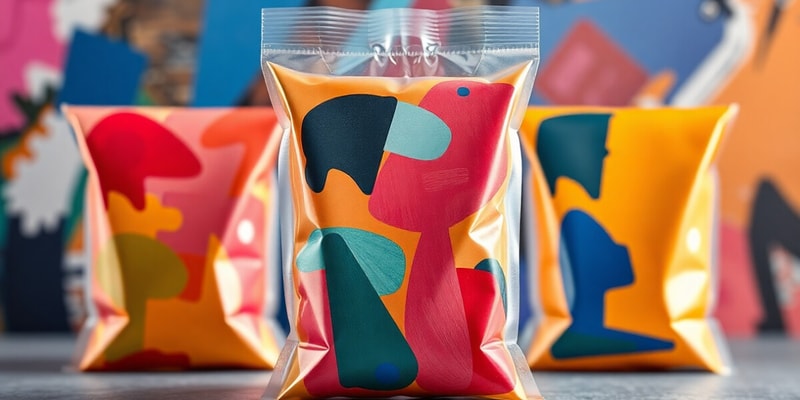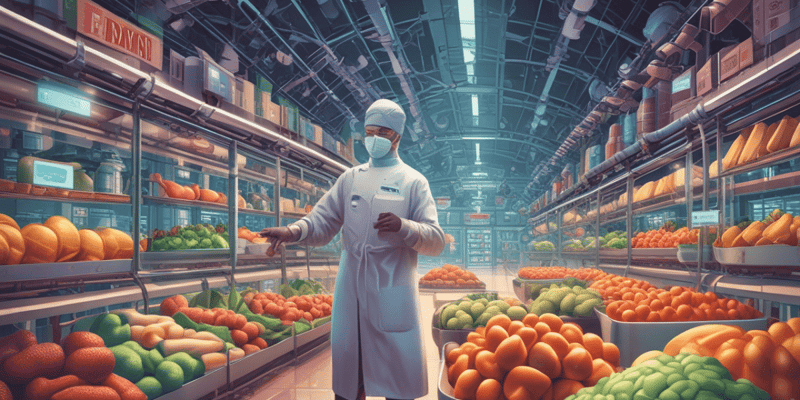Podcast
Questions and Answers
What is the primary purpose of Modified Atmosphere Packaging (MAP)?
What is the primary purpose of Modified Atmosphere Packaging (MAP)?
What does vacuum packaging accomplish in food preservation?
What does vacuum packaging accomplish in food preservation?
Which type of foods are commonly packaged using MAP?
Which type of foods are commonly packaged using MAP?
Which gases are typically altered in MAP to extend shelf-life?
Which gases are typically altered in MAP to extend shelf-life?
Signup and view all the answers
What property must materials have for effective MAP?
What property must materials have for effective MAP?
Signup and view all the answers
How does chilling food contribute to food preservation?
How does chilling food contribute to food preservation?
Signup and view all the answers
What is the key characteristic of ambient foods?
What is the key characteristic of ambient foods?
Signup and view all the answers
What is the primary purpose of using polyamide (nylon) in vacuum packaging?
What is the primary purpose of using polyamide (nylon) in vacuum packaging?
Signup and view all the answers
Equilibrium Modified Atmosphere Packaging (EMAP) is most commonly used for which food product?
Equilibrium Modified Atmosphere Packaging (EMAP) is most commonly used for which food product?
Signup and view all the answers
Which of the following is a characteristic of modified atmosphere packaging?
Which of the following is a characteristic of modified atmosphere packaging?
Signup and view all the answers
What is a key characteristic of Modified Atmosphere Packaging (MAP)?
What is a key characteristic of Modified Atmosphere Packaging (MAP)?
Signup and view all the answers
What is the primary advantage of using thermoplastic polymers in food packaging?
What is the primary advantage of using thermoplastic polymers in food packaging?
Signup and view all the answers
What is the recommended action for vacuum packaged food at home?
What is the recommended action for vacuum packaged food at home?
Signup and view all the answers
What process is critical for ensuring the safety of low-acid foods in canning?
What process is critical for ensuring the safety of low-acid foods in canning?
Signup and view all the answers
Which method is typically not associated with ambient food preservation?
Which method is typically not associated with ambient food preservation?
Signup and view all the answers
Which of the following strategies is typically used for extending shelf life in food products?
Which of the following strategies is typically used for extending shelf life in food products?
Signup and view all the answers
Which property is NOT a feature of thermoplastic polymers used in packaging?
Which property is NOT a feature of thermoplastic polymers used in packaging?
Signup and view all the answers
What is the primary benefit of using vacuum packaging techniques?
What is the primary benefit of using vacuum packaging techniques?
Signup and view all the answers
What role does the lacquer coating inside food cans play?
What role does the lacquer coating inside food cans play?
Signup and view all the answers
Why is polyethylene terephthalate (PET) commonly used for rigid plastic bottles?
Why is polyethylene terephthalate (PET) commonly used for rigid plastic bottles?
Signup and view all the answers
What type of packaging is used for ambient foods to ensure long shelf life?
What type of packaging is used for ambient foods to ensure long shelf life?
Signup and view all the answers
Which of the following conditions is least likely to be addressed by using cellulose films in food packaging?
Which of the following conditions is least likely to be addressed by using cellulose films in food packaging?
Signup and view all the answers
Why is it important to maintain low moisture content in the storage of cereals and pulses?
Why is it important to maintain low moisture content in the storage of cereals and pulses?
Signup and view all the answers
What should be done once vacuum packaging is opened?
What should be done once vacuum packaging is opened?
Signup and view all the answers
Study Notes
Food Packaging
- Food packaging methods aim to preserve quality, extend shelf life, and protect food products.
- Modified Atmosphere Packaging (MAP) involves altering the gas composition surrounding the food inside a package to limit microbial activity and extend shelf life.
- MAP primarily uses thermoplastic polymers for package material.
- Popular MAP applications include meat, fish, fruits, and vegetables.
- Equilibrium modified atmosphere packaging (EMAP) is commonly used for fresh-cut produce.
- Vacuum packaging entails removing air from a sealed package to extend shelf life.
- Vacuum packaging methods include using films with varying permeability for different food types like fruits and vegetables.
- Food should be consumed within ten days if vacuum packed at home.
- Once opened, vacuum-packed food should be refrigerated and eaten within two days.
Ambient Food Products
- Ambient food products are stored and sold at room temperature, typically have a long shelf life, and are processed to render them safe for consumption.
- Pasteurization and sterilization are the primary heat treatments employed in ambient food production.
- The heat treatment aims to eliminate harmful microorganisms.
- Spore-forming bacteria can survive in canned fruit juice, but safety relies on maintaining a low pH to inhibit their growth.
- Low-acid foods undergo a rigorous heat treatment known as the "Botulinum cook" to reduce the number of Clostridium botulinum spores to a safe level.
- Ambient foods like cereals, rice, and pulses must be stored carefully to minimize moisture content and prevent mold and yeast spoilage.
The Purpose of Packaging Design
- Packaging design needs to address several factors beyond food preservation, including hygiene, safety, and consumer convenience.
- The chosen material should be compatible with the food product, preventing chemical reactions.
- Cans, traditionally made of tin plate, have increasingly transitioned to aluminum for drinks.
- The inner surface of cans is coated with lacquer to prevent rusting and reactions with acidic foods.
- Paper, board, and foil are commonly used for food packaging.
- Board for food packaging is often coated with wax or polythene to prevent interaction with the contents.
- Most paper or board products should be discarded before heating, while some specifically treated board products can be used for microwaving.
- Foil trays are suitable for both freezing and heating in conventional ovens.
Different Plastics Used in Food Packaging
- Polythene (low density) is widely used for film wrapping due to its water resistance.
- High-density polythene is favored for "boil-in-the-bag" products.
- Polyamide (nylon) provides an excellent oxygen barrier, making it suitable for vacuum packaging, particularly for fatty foods.
- Polyethylene terephthalate (PET) is used for rigid plastic bottles, offering lightness, low breakage risk, and CO2 retention for carbonated drinks.
- Expanded polystyrene is employed for trays and insulated containers to keep food at desired temperatures (e.g., ice cream, coffee).
Cellulose Films in Food Packaging
- Cellulose films are used extensively in food packaging due to their versatility and range of properties, including:
- Flexibility for shaping
- Light weight
- Gas barrier properties
- Sealability
- Printability
- Resistance to physical stress
- Aesthetic appeal
- Multi-layering capability for enhanced properties
Studying That Suits You
Use AI to generate personalized quizzes and flashcards to suit your learning preferences.
Related Documents
Description
This quiz focuses on various food packaging methods, including Modified Atmosphere Packaging (MAP) and vacuum packaging. It covers how these methods help in preserving food quality and extending shelf life. You'll also explore the applications of these techniques in different food products.




